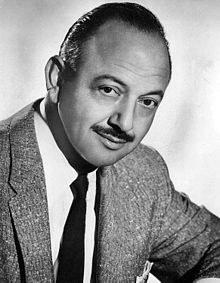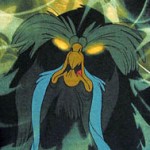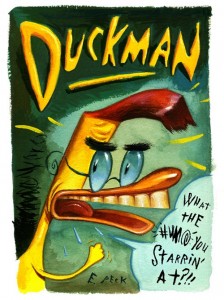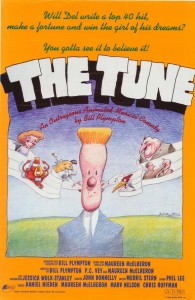
Mel Blanc
“A musician who can competently play every instrument in an orchestra is not a one-man band, and Mel Blanc’s virtuosity, his almost limitless ability to understand the essence of a character and to invest himself into its being is what made him so consummate an artist. He was an actor in the best tradition of a proud profession.”
Schneider on Roger Rabbit. In the Los Angeles Times July 27, 1989, Disney vice-president Peter Schneider said, “I don’t think Disney has created a character of the magnitude of Roger (Rabbit) in the last thirty years – a character that the public perceives as being unique, the way Mickey Mouse is unique, who jumps off the screen into people’s laps. Yes, we’re considering a sequel to the feature but we’re also doing the short cartoons. What better way to keep the character alive than using him correctly?
 “Honey (Honey, I Shrunk the Kids) is a very strong successful movie in its own right but its entertainment value is enhanced by the cartoon (Tummy Trouble 1989). Who Framed Roger Rabbit was hailed as a masterpiece of technique, animation and concept. When you follow that kind of success, it’s very easy to trip and fall. We were committed to doing something at the same level of quality as the feature. I feel we were successful and I’m pleased by the film’s success.”
“Honey (Honey, I Shrunk the Kids) is a very strong successful movie in its own right but its entertainment value is enhanced by the cartoon (Tummy Trouble 1989). Who Framed Roger Rabbit was hailed as a masterpiece of technique, animation and concept. When you follow that kind of success, it’s very easy to trip and fall. We were committed to doing something at the same level of quality as the feature. I feel we were successful and I’m pleased by the film’s success.”
 Animated TV Series That Never Were. In 1991, it was announced that Marvel Productions was going to create a 65 episode syndicated animated series entitled “Siegried & Roy — Masters of the Impossible”. The two magician illusionists would be superheroes battling a sorceress as they defended the environment. Production was supposedly going to start in September or early October for a fall 1992 launch.
Animated TV Series That Never Were. In 1991, it was announced that Marvel Productions was going to create a 65 episode syndicated animated series entitled “Siegried & Roy — Masters of the Impossible”. The two magician illusionists would be superheroes battling a sorceress as they defended the environment. Production was supposedly going to start in September or early October for a fall 1992 launch.
At the moment, there were seeking Japanese, Asian and European partners to co-finance the action-adventures series. Marvel President said that the series had great internaional potential. In 1996, DIC Enterprises did a four part CGI series with the entertaners. The series called “Legend Of Sarmoti: Siegfried & Roy” was later re-named Siegried & Roy — Masters of the Impossible and edited into a straight-to-video movie. Neither of these projects had any connection with the ill-fated NBC/Dreamworks series “Father of the Pride” that debuted in 2004.
Giving a Hoot. In Volume 1, No. 1 (January 1982) The Secret of Nimh newsletter, sound effects editor David Horton shared the story of waiting to record an owl’s hoots for forty-five minutes: “I have trouble in my work getting the surroundings quiet enough to record the sounds I need, so I wait until quite late if there’s an outside sound I want.
 “One night I waited until past midnight to record two owls who live in the tree outside my house. I perched with my Nagra (sound equipment) and waited, listening while the owls carried on their conversation and readying to record the hoots to come.
“One night I waited until past midnight to record two owls who live in the tree outside my house. I perched with my Nagra (sound equipment) and waited, listening while the owls carried on their conversation and readying to record the hoots to come.
“As luck would have it, my neighbors had a party that night and just as the hooting began, the party broke up. I waited forty-five minutes for the guests to pack up and leave, then got all ready again to turn on the machine. I pressed the button, happy for the silence at last and…both owls flew away.”
 Duckman’s Biggest Fan. In Liz Smith’s column for April 19, 1994 it stated, “What is (actress) Elizabeth Taylor doing while recuperating from her recent hip surgery? In between grueling physiotherapy, the star is watching…’Duckman’! That’s right. Miz Liz just adores the hot, new animated series, which airs over the USA network. Elizabeth asked for all the completed episodes and requests for cassettes have also come from the likes of Tom Cruise and Steven Spielberg.”
Duckman’s Biggest Fan. In Liz Smith’s column for April 19, 1994 it stated, “What is (actress) Elizabeth Taylor doing while recuperating from her recent hip surgery? In between grueling physiotherapy, the star is watching…’Duckman’! That’s right. Miz Liz just adores the hot, new animated series, which airs over the USA network. Elizabeth asked for all the completed episodes and requests for cassettes have also come from the likes of Tom Cruise and Steven Spielberg.”
Plympton on The Tune. In The Daily News September 14, 1992, animator Bill Plympton talked about his animated feature release The Tune (1992): “it started out around 1989. I had been doing short films for seven years. They were fairly — in fact, really – successful. So I just decided I wanted to do a feature. It was a goal since I saw Song of the South.
 “Me and two assistants did all the art in the film. On Beauty and the Beast, they used 600 artists. I would call the look an edge style. The music equivalent would be a rock’n’roll garage band, sort of raw and energetic, whereas Disney is sweet and airbrushed. My film is geared mainly toward the MTV audience.
“Me and two assistants did all the art in the film. On Beauty and the Beast, they used 600 artists. I would call the look an edge style. The music equivalent would be a rock’n’roll garage band, sort of raw and energetic, whereas Disney is sweet and airbrushed. My film is geared mainly toward the MTV audience.
“I didn’t realize it was such an unheard-of feat until I finished it. It just seemed to make sense to me because all of the ideas came out of my head and I knew how they looked. Plus, I didn’t have enough money to pay other animators. The whole cost was $175,00 without my salary. That is, if I had been paid a salary.
“In 1989, we got thr idea of doing a movie about a songwriter. One small company that was interested in producing it went bankrupt. We realized that no major studio would invest in a cartoon feture that showed a rock flying through somebody’s head or a bird flying out of their nose. My film is something that people have never seen before. There’s some surreal, violent, twisted humor that most people don’t expect in cartoons.
“It was too off-the-wall for Hollywood, so we financed it by selling off rights to the short segments of the film after they were done to MTV and the Tournee of Animation. Then I got a couple of commericals for Trivial Pursuit and Nutra-Sweet. That paid for the rest.
“The music is a big part of it. It’s really roots kind of music – blues, rockabilly – not kids’ music at all. The songs were all written by Maureen McElheron. We had a band together back in the 1970s. I always loved her music and wanted to make a feature with her songs in it.
“I won’t make another feature film alone.”


 Jim Korkis is an internationally respected animation historian who in recent years has devoted his attention to the many worlds of Disney. He was a columnist for a variety of animation magazines. With his former writing partner, John Cawley, he authored several animation related books including The Encyclopedia of Cartoon Superstars, How to Create Animation, Cartoon Confidential and Get Animated’s Animation Art Buyer’s Guide. He taught animation classes at the Disney Institute in Florida as well as instructing classes on acting and animation history for Disney Feature Animation: Florida.
Jim Korkis is an internationally respected animation historian who in recent years has devoted his attention to the many worlds of Disney. He was a columnist for a variety of animation magazines. With his former writing partner, John Cawley, he authored several animation related books including The Encyclopedia of Cartoon Superstars, How to Create Animation, Cartoon Confidential and Get Animated’s Animation Art Buyer’s Guide. He taught animation classes at the Disney Institute in Florida as well as instructing classes on acting and animation history for Disney Feature Animation: Florida.




















































I heard that Father of the Pride was according to the critics a type of South Park takeoff with characters “stealing” Eric Cartman’s famous catchphrase “Screw you guys, I’m goin’ home!” With two”lost” episodes which were never aired and one episode that was never created.
Yeah, plus the Parents Television Council accused the show of tricking children into watching it by saying it’s from the creators of “Shrek”. It didn’t help that Donkey guest-starred in one episode.
It’s a stretch to call FATHER a SOPK knock-off. It was actually quite good-natured, and Carl Reiner was a stitch as the grandfather lion. The series was released on DVD and there may still be copies around.
Inspired by reading his comments, I looked up Bill Plympton on IMDb. Astounding how much work he has produced over the years, and I haven’t seen or even heard of most of it. Pity, because he’s one of a kind: a guy whose drawing style is technically solid, who is constantly surprising you with his inventive ways of stretching and distorting forms in ways no digital animator ever thought of. He’s too often taken for granted, but gosh, what a treasure.
Pencil and paper, folks – it’s all you need.